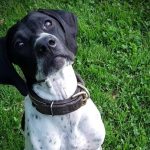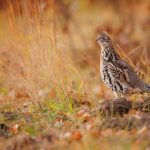Pointing Dog Pointers: Man-Made Faults
By Bob and Jody Iler
No one sets out to train his pointing dog and create problems in the process!
As trainers, we’ve had the advantage of working with many dogs and dealing with a lot of issues. We’ve found that some of these issues could have been prevented or may not have come up at all if it weren’t for the dog’s well-intentioned, but novice, trainer-owner. We can often trace the origin of a problem to something that we ourselves have inadvertently done. Let’s take a closer look at some of the “man-made faults” your dog may have developed, along with possible reasons why and what you can do about them.
Doesn’t Handle Well
When you turn him loose in the field, is your dog running out of the county and ignoring your whistle or voice commands to “come around” or to come back to you? Often these dogs will begin to self-hunt as well, not forming that key bond with you that is so necessary to the hunting partnership. Young dogs that are frequently hunted with other dogs often “unlearn” their training and start to follow the crowd, paying no attention to you. By not setting the stage for being able to control your dog, you are creating a man-made fault.
If this issue applies to your dog, it’s likely that you haven’t laid the foundation work needed for your dog to handle kindly. You can’t make your dog come around in the field or come back to you unless you have done this. Good foundation work means being able to enforce the come command or the come around directive. Get out your checkcord and go back to the basics, with regular sessions in a large yard or field with low cover.
Practice quartering, moving straight out, and other various patterns and snap that checkcord smartly and effectively each time you prompt your dog with a command. You may need to keep the checkcord on for several weeks or longer while you re-instill who is in charge. As your dog improves, you can let him drag the checkcord. And, as that improves, let him run with a shorter lead attached to his collar, fooling him into thinking that you still have complete control. We don’t advise using an e-collar at this point, especially if your dog is less than two years old and new to hunting. The e-collar could take away his enthusiasm for birds. Down the road, when pup understands that he must come when you call him, you can carefully add the e-collar as a reinforcement only (using the lowest setting he responds to), always watching for any adverse reaction.
Won’t Pick Up or Retrieve a Bird
Does your dog run out to the downed bird, but refuse to pick it up? Or does he avoid the killed bird altogether? Does he show reluctance to mouth or pick up a hobbled or trussed up bird in training sessions? Maybe your dog refuses to even run out to the bird when it is shot. Perhaps he shows no interest at all, or possibly even drops his tail and moves away.
Some dogs show no interest in picking up birds as part of their genetic makeup. But if your dog started out liking the birds and picking them up and has now stopped doing this, or even avoids a trussed-up bird, that’s a red flag that something has happened to cause this. A friend of ours began to use his e-collar to encourage his Shorthair to pick up the bird during the few times when she dropped it. This had the opposite effect: she soon refused to pick up birds at all. She had made an unpleasant association with the birds from the e-collar stimulus. Now he had created a problem he didn’t originally have. A man-made fault.

When it comes to the retrieve everything should be positive!
All things having to do with birds should be positive and pleasant in your dog’s mind. Never jam a bird into your pup’s mouth and forcibly hold his jaws shut to “train” him to hold a bird. We’ve seen this done at a seminar and can assure you it wasn’t a pleasant experience for the pup. Improper methods of teaching a dog to retrieve can often turn them off of birds entirely. Back off and let your dog come to this naturally, with no more pressure or insistence. You may not get him to pick up a bird again, but give it time and let him hunt and have opportunities to either find and mouth the bird or to retrieve it. Enlist the help of a gentle, light-handed trainer if you feel you must have your dog retrieving, especially if you have a soft dog.
Blinks Birds
Your dog may acknowledge that a bird is there in the cover by pointing, but then going off point and leaving the immediate area. Or he may avoid a bird in the cover completely. If you watch closely, you can see that he scents the bird, but quickly moves away.
Blinking birds can usually be traced to an unpleasant association with birds as well. Trying to steady a young dog to wing and shot before he’s ready, or using too much training pressure on a dog can result in blinking. Sometimes the use of a noisy electronic trap can spook a dog and cause him to blink birds.
Since most genetically sound pups love birds innately, blinking birds is cause for us to examine what we have done with our pup in relation to birds that has caused him to avoid them. Once we pinpoint this, we can stop it. Then, the pup must have only fun associations with birds. No training or discipline, no restrictions, no pressure or demands. Let him find lots of quail, chase and have fun. It will take time but is well worth the effort. Until you can re-establish pup’s enthusiasm and drive for birds, put aside any other training for as long as it takes.
Fear of Birds
When training your dog or hunting with him, does your dog run away from a flushed bird? Does he act spooked or afraid of the bird? As with the other instances above where your pup avoids birds, something has happened to make him fearful. Electronic traps may have scared him. The use of bigger game birds early on may have spooked him with the loud flushing noise or maybe he’s been spurred by a crippled rooster.
Go back to the puppy basics and keep things simple and positive. Start with hobbled and trussed quail to stoke his interest and enthusiasm. As that grows, you can let him chase and catch poor flying quail. Don’t worry about other training at this point. All you want is to restore his love for birds and build his confidence.
False Pointing
Your dog may show lots of point, but each time you search, no bird is there. He may do this often, with many unproductive points. You may not have caused this problem but most owners are so delighted with their dogs’ staunch points that they continue to praise and encourage these false points. Make sure that scenting conditions are good and no birds have run out recently. Don’t compliment your dog when pointing; rather, ignore him and walk past him. He’ll eventually catch up to you and continue hunting. It may take several outings or more but is worth the time.
Flagging on Point
When your dog goes on point, his tail may wave back and forth, or “flag.” This can be a genetic problem, or it could be a man-made fault. Leaving your dog on point too long or excessively handling him by commanding whoa over and over while he’s on point can cause flagging. Try to handle your dog as quietly as possible, with few words and just one whoa command. Avoid keeping him on point for too long and flush your bird quickly. If necessary, go back to your yard training and instill what the whoa command means.

One whoa command is enough.
Dropping on Point
This dog crouches down when he goes on point, which can be difficult to correct once he’s started doing this. Too much training pressure, steadying to wing and shot too soon, and overuse of the e-collar in training can cause this. A possible remedy is to “untrain” him by letting him break at the shot while killing birds over him. This keeps him on his feet and moving.
Gun Nervous or Gun Shy
Your dog may stop hunting at the sound of the gun. He may even bolt out of the field or run to your vehicle and try to hide. Some dogs react badly to just the sight of the gun. Of all the problems our bird dogs can develop, this one is most often a man-made fault.

Prevent guy shyness – one shot, one hunter, one dog at a time.
Young dogs shouldn’t be hunted with other hunters and dogs in the first or second seasons. Only one or two shots should be fired at a time, by one hunter. The bird that is shot should be one worked by the dog. Most important of all is the foundation laid for pup’s gun development, done on a step by step basis with the gradual progression of noise level as pup’s reaction is constantly monitored. The pup’s focus should always be on the birds during his gun development, so that the whole training process is a positive experience. A good resource to refer to is our article “The Gun-Shy Pointing Dog” in the July/August 1999 issue of PDJ.
If you’ve created a man-made fault in your dog, don’t feel bad! We’ve all done this at one time or another. The key is to resolve the issue and learn from it. Good luck!
Pointing Dog Pointers features monthly training tips by Bob and Jody Iler, who operated Green Valley Kennels in Dubuque, Iowa, training pointing dogs for 50 years. Bob and Jody have written many articles for The Pointing Dog Journal.





